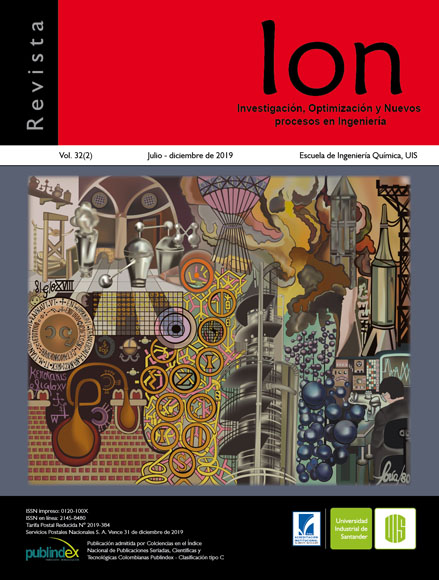Evaluación de mucilage y polvo de Quimbombó como biofloculante en el tratamiento de aguas
Publicado 2019-12-17
Palabras clave
- Biofloculante, quingombó, eliminación de turbidez, mucílago, polvo de quimbombó, tratamiento de agua
Cómo citar
Resumen
El mucílago y el polvo de quimbombó se evaluaron como biofloculante en el tratamiento del agua usando la prueba jar. Los conjuntos de agitación, los métodos de preparación de quimbombó y la cantidad de coagulante / biofloculante se evaluaron en la eliminación de la turbidez. Los resultados mostraron que las agitaciones establecidas de 150 rpm y luego de 40 rpm fueron más efectivas para reducir la turbidez. Los resultados mostraron que al usar 80 mg l-1 de coagulante se observó un 39% de eliminación de turbidez y la adición de mucílago y polvo de quimbombó fue de hasta 76% y 88%, respectivamente. Por lo tanto, todos los resultados mostraron que el polvo de quimbombó presenta una mejor eliminación de la turbiedad en el tratamiento del agua. Puede prepararse por metodología simple y también permite la reducción del coagulante en aproximadamente 64%. En polvo de quimbombó se identificaron grupos hidroxilo que sirven como sitios activos para la eliminación de partículas coloidales.
Descargas
Referencias
[2] Freitas TKFS, Oliveira VM, De Souza MTF, Geraldino HCL, Almeida VC, Fávaro SL, Garcia JC. Optimization of coagulation-flocculation process for treatment of industrial textile wastewater using okra (A. esculentus) mucilage as natural coagulant. Industrial Crops and Products Journal. 2015;76:538-44.
[3] Jarvis P, Jefferson B, Gregory JOHN, Parsons SA. A review of floc strength and breakage. Water research. 2005;39:3121-37.
[4] Choy SY, Prasad KMN, Wu TY, Ramanan RN. A review on common vegetables and legumes as promising plant-based natural coagulants in water clarification. International Journal of Environmental Science and Technology. 2015;12:367-90.
[5] Lee CS, Chong MF, Robinson J, Binner E. Optimisation of extraction and sludge dewatering efficiencies of bio-flocculants extracted from Abelmoschus esculentus(Okra). Journal of Environmental Management. 2015;157:320-5.
[6] Anastasakis K, Kalderis D, Diamadopoulos E. Flocculation behavior of mallow and okra mucilage in treating wastewater. Desalination Journal. 2009;249:786-91.
[7] Bolto B, Gregory J. Organic polyelectrolytes in water treatment. Water Research Journal. 2007;41:2301–24.
[8] Kumar DS, Tony DE, Kumar AP, Kumar KA, Srinivasa DB, Nadendla R. A review on Abelmoschus esculentus (Okra). Int Res J Pharm App Sci. 2013;3:129-32.
[9] Finger FL, Della-Justina ME, Casali VWD, Puiatti M. Temperature and modified atmosphere affect the quality of okra. Scientia Agricola. 2008;65:360-4.
[10] Kitinoja L, AlHassan HY. Identification of appropriate postharvest technologies for small scale horticultural farmers and marketers in sub-saharan Africa and south Asia - part 1 postharvest losses and quality assessments. Acta Hortic. 2012;934:31-40.
[11] Okolo BI, Menkiti MC, Nnaji PC, Onukwuli OD, Agu CC. The Performance of Okra seed (Hibiscus esculentus L.) Extract in Removal of Suspended Particles from Brewery Effluent by Coag-Flocculation Process. British Journal of Applied Science & Technology.2014;34:4791-806.
[12] Ding Y, Chen J, Gong W. Synthesis and flocculation characteristics of cationic modified corncob: a novel polymeric flocculant. Agricultural Sciences Journal. 2013;4:23–8.
[13] Jones AN, Bridgeman J. Investigating the characteristic strength of flocs formed from crude and purified Hibiscus extracts in water treatment. Water research. 2016;103:21-9.
[14] Thakur SS, Choubey S. Assessment of coagulation efficiency of Moringa oleifera and Okra for treatment of turbid water. Archives of Applied Science Research. 2014;6:24-30.
[15] Aziz HA, Alias S, Adlan MN, Asaari AH, Zahari MS. Colour removal from landfill leachate by coagulation and flocculation processes. Bioresource technology. 2007;98:218-20.
[16] Jesus E, Cruz PV, Pacífico JA, Silva AS. Removal of turbidity, suspended solids and ions of Fe from aqueous solution using okra powder by coagulation-flocculation process. American journal of water resources. 2013;1:20-4.
[17] Palei NN, Mamidi SK, Rajangam J. Formulation and evaluation of lamivudine sustained release tablet using okra mucilage. J App Pharm Sci. 2016;6:069-75.
[18] Jahan MS, Alam D, Rahman MM, Quaiyyum MA. Isolation and characterization of lignin from okra (Abelmoschus esculentus) fibre and stick. Bangladesh Journal of Scientific and Industrial Research. 2015;50:257-62.
[19] De Rosa IM, Kenny JM, Maniruzzaman M, Moniruzzaman M, Monti M, Puglia D, Santulli C, Sarasini F. Effect of chemical treatments on the mechanical and thermal behaviour of okra (Abelmoschus esculentus) fibres. Composites Science and Technology. 2011;71:246-54.

